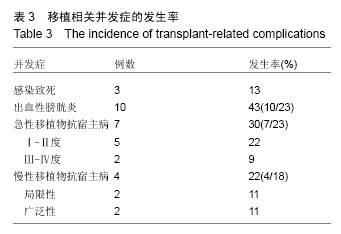| [1] Chen XH, Gao L, Zhang X, et al. HLA-haploidentical blood and bone marrow transplantation with anti-thymocyte globulin: long-term comparison with HLA-identical sibling transplantation. Blood Cells Mol Dis. 2009;43(1):98-104.
[2] 赵桐茂,洪峻岭,刘静湖.在中华骨髓库找到HLA匹配无关供者的概率[J].中国输血杂志,2013,26(6):506-510.
[3] 张之南,沈梯,血液病诊断与疗效标准[M].北京:科学出版社,2008:131-139.
[4] Thomas E,Storb R,Cliff RA,et al. Bone-marrow transplantation. N Engl J Med.1975;292:832-843.
[5] 余正平,丁家华,陈宝安,等.异基因造血干细胞移植后急性移植物抗宿主病临床研究[J].白血病•淋巴瘤,2010, 19(12): 714-717.
[6] 沈耀耀,刘跃均,吴德沛,等.异基因造血干细胞移植后免疫重建的临床研究及急性移植物抗宿主病的危险因素分析[J].白血病•淋巴瘤,2015,24(6):346-351.
[7] Petersdorf EW. Genetics of graft-versus-host disease: the major histocompatibility complex. Blood Rev. 2013; 27(1):1-12.
[8] Lazaryan A, Weisdorf DJ, DeFor T, et al. Risk Factors for Acute and Chronic Graft-versus-Host Disease after Allogeneic Hematopoietic Cell Transplantation with Umbilical Cord Blood and Matched Sibling Donors. Biol Blood Marrow Transplant. 2016;22(1): 134-140.
[9] 陈波,王志国,张颢,等.HLA相合同胞异基因外周血造血干细胞移植治疗急性白血病[J].中国组织工程研究与临床康复,2011,15(27):5123-5126.
[10] Champlin RE, Schmitz N, Horowitz MM, et al. Blood stem cells compared with bone marrow as a source of hematopoietic cells for allogeneic transplantation. IBMTR Histocompatibility and Stem Cell Sources Working Committee and the European Group for Blood and Marrow Transplantation (EBMT). Blood. 2000; 95(12):3702-3709.
[11] Lazarus HM, Vogelsang GB, Rowe JM. Prevention and treatment of acute graft-versus-host disease: the old and the new. A report from the Eastern Cooperative Oncology Group (ECOG). Bone Marrow Transplant. 1997;19(6):577-600.
[12] Funke VA, de Medeiros CR, Setúbal DC, et al. Therapy for severe refractory acute graft-versus-host disease with basiliximab, a selective interleukin-2 receptor antagonist. Bone Marrow Transplant. 2006;37(10): 961-965.
[13] Bernardo ME, Ball LM, Cometa AM, et al. Co-infusion of ex vivo-expanded, parental MSCs prevents life-threatening acute GVHD, but does not reduce the risk of graft failure in pediatric patients undergoing allogeneic umbilical cord blood transplantation. Bone Marrow Transplant. 2011;46(2):200-207.
[14] Kuzmina LA, Petinati NA, Parovichnikova EN, et al. Multipotent Mesenchymal Stromal Cells for the Prophylaxis of Acute Graft-versus-Host Disease-A Phase II Study. Stem Cells Int. 2012;2012:968213.
[15] Wu Y, Wang Z, Cao Y, et al. Cotransplantation of haploidentical hematopoietic and umbilical cord mesenchymal stem cells with a myeloablative regimen for refractory/relapsed hematologic malignancy. Ann Hematol. 2013;92(12):1675-1684.
[16] Sánchez-Guijo F, Caballero-Velázquez T, López-Villar O, et al. Sequential third-party mesenchymal stromal cell therapy for refractory acute graft-versus-host disease. Biol Blood Marrow Transplant. 2014;20(10): 1580-1585.
[17] Introna M, Lucchini G, Dander E, et al. Treatment of graft versus host disease with mesenchymal stromal cells: a phase I study on 40 adult and pediatric patients. Biol Blood Marrow Transplant. 2014;20(3): 375-381.
[18] Zhao K, Lou R, Huang F, et al. Immunomodulation effects of mesenchymal stromal cells on acute graft-versus-host disease after hematopoietic stem cell transplantation. Biol Blood Marrow Transplant. 2015; 21(1):97-104.
[19] Batista CK, Mota JM, Souza ML, et al. Amifostine and glutathione prevent ifosfamide- and acrolein-induced hemorrhagic cystitis. Cancer Chemother Pharmacol. 2007;59(1):71-77.
[20] 施继敏,景晶,罗依.异基因造血干细胞移植后并发出血性膀胱炎的高危因素和防治措施[J].中华器官移植杂志, 2011; 32(3):148-151.
[21] 宋闿迪,孙自敏,刘会兰.造血干细胞移植后发生出血性膀胱炎危险因素的分析[J].临床内科杂志,2009:26(2): 132-134.
[22] 马向娟,任汉云,邱志祥.造血干细胞移植后出血性膀胱炎多因素分析[J].中国实验血液学杂志,2010,18(4): 1007-1012.
[23] Lee GW, Lee JH, Choi SJ, et al. Hemorrhagic cystitis following allogeneic hematopoietic cell transplantation. J Korean Med Sci. 2003;18(2):191-195.
[24] Leung AY, Mak R, Lie AK, et al. Clinicopathological features and risk factors of clinically overt haemorrhagic cystitis complicating bone marrow transplantation. Bone Marrow Transplant. 2002;29(6): 509-513.
[25] Ruggeri A, Roth-Guepin G, Battipaglia G, et al. Incidence and risk factors for hemorrhagic cystitis in unmanipulated haploidentical transplant recipients. Transpl Infect Dis. 2015;17(6):822-830.
[26] 王苓,唐暐,王莹,等.异基因造血干细胞移植后迟发性出血性膀胱炎与移植供受体性别差异、抗胸腺细胞球蛋白应用及急性移植物抗宿主病有关[J].白血病•淋巴瘤,2013, 22(7):410-414.
[27] Qian L, Shen J, Zhao D, et al. Successful treatment of hemorrhagic cystitis after HLA-mismatched allogeneic hematopoietic stem cell transplantation by hyperbaric oxygen. Transplantation. 2014;97(7):e41-42.
[28] 贾锐,杨晓凤,陆岩,等.脐带间充质干细胞治疗儿童造血干细胞移植后出血性膀胱炎8例观察[J].中国当代儿科杂志, 2014,14(7):554-557.
[29] Champlin R, Jabbour E, Kebriaei P, et al. Allogeneic stem cell transplantation for chronic myeloid leukemia resistant to tyrosine kinase inhibitors. Clin Lymphoma Myeloma Leuk. 2011;11 Suppl 1:S96-100.
[30] Gratwohl A, Brand R, Apperley J, et al. Allogeneic hematopoietic stem cell transplantation for chronic myeloid leukemia in Europe 2006: transplant activity, long-term data and current results. An analysis by the Chronic Leukemia Working Party of the European Group for Blood and Marrow Transplantation (EBMT). Haematologica. 2006;91(4):513-521.
[31] Nicolini FE, Mauro MJ, Martinelli G, et al. Epidemiologic study on survival of chronic myeloid leukemia and Ph(+) acute lymphoblastic leukemia patients with BCR-ABL T315I mutation. Blood. 2009; 114(26):5271-5278.
[32] 常英军,赵翔宇,黄晓军.G-CSF的免疫调节作用及其在异基因造血干细胞移植中的应用[J].中国实验血液学杂志, 2007,15(5):1121-1125.
[33] Holtick U, Albrecht M, Chemnitz JM, et al. Comparison of bone marrow versus peripheral blood allogeneic hematopoietic stem cell transplantation for hematological malignancies in adults - a systematic review and meta-analysis. Crit Rev Oncol Hematol. 2015;94(2):179-188.
[34] 邱大发,许晓军,郭子文,等.单倍体相合异基因造血干细胞移植治疗白血病[J].中国组织工程研究与临床康复, 2011, 15(23):4251-4256.
[35] 万鼎铭,邵运丽,秦童,等.HLA单倍体与全相合异基因造血干细胞移植治疗恶性血液病[J]. 中国组织工程研究与临床康复,2012, 16(32): 6076-6080.
[36] Luo R, Wanming DA, Zhang X, et al. The safety and efficacy of hematopoietic stem cell transplantation for 22 children with high-risk hematologic malignancies. Journal of China Pediatric Blood & Cancer, 2013; 18(6): 255-258.
[37] Yang K, Si Y, Chen H, et al. Comparative study of the efficacy of allogeneic hematopoietic stem cell transplantation from human leukocyte antigen-haploidentical related and unrelated donors in the treatment of leukemia. Acta Haematol. 2014;131(1): 37-44.
[38] Di Stasi A, Milton DR, Poon LM, et al. Similar transplantation outcomes for acute myeloid leukemia and myelodysplastic syndrome patients with haploidentical versus 10/10 human leukocyte antigen-matched unrelated and related donors. Biol Blood Marrow Transplant. 2014;20(12):1975-1981.
[39] Piemontese S, Ciceri F, Labopin M, et al. A survey on unmanipulated haploidentical hematopoietic stem cell transplantation in adults with acute leukemia. Leukemia. 2015;29(5):1069-1075.
[40] Wang Y, Chang YJ, Xu LP, et al. Who is the best donor for a related HLA haplotype-mismatched transplant. Blood. 2014;124(6):843-850. |
.jpg)


.jpg)
.jpg)
.jpg)